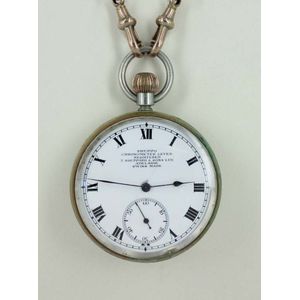Antique Sterling Silver Pocket Watch with Key and Chain
You must be a subscriber, and be logged in to view price and dealer details.
Subscribe Now to view actual auction price for this item
When you subscribe, you have the option of setting the currency in which to display prices to $Au, $US, $NZ or Stg.
- Fusee - The fusee movement was used in clocks and pocket watches from the mid 17th century. The fusee is a cone shaped drum within the works that is linked to the barrel of the spring, usually by a length of chain.
As the mainspring loses its tension over time, the cone shaped barrel compensates for this by increasing the tension, by pulling the mainspring tighter, thus ensuring the time remains constant.
Use of the fusee in clocks was superseded by the "going barrel" in the mid 19th century and for pocket watches at the beginning of the 19th century.
The fusee continued to be used in marine chronometers until the 1970s. - Chapter Ring - A separate metal plate on the face of a clock, on which the numerals for the hours and sometimes parts of the hours, are displayed, usually wheel shaped and sitting on top of the dial plate. The chapter ring is often a feature of the clock and can be silvered or enamelled to stand as a contrast to its background. The hours are usually shown in Roman numerals, although in the late 19th and earlt 20th century, Arabic numerals became fashionable.
- Movement - The technical name for the workings of a clock or watch, and does not include the dial or case.
- Sterling Silver - Sterling silver is a mixture of 92.5% pure silver and 7.5% of another metal, usually copper. Fine silver is 99.9% pure silver, and is relatively soft and the addition of the very small amount of copper gives the metal enough strength and hardness to be worked into jewellery, decorative and household objects.
This item has been included into following indexes:
-
pocket watches, case type
- open face, silver case 553
- silver case 865
Visually similar items

A Victorian sterling silver, pair cased pocket, watch, hallmarked Birmingham, c.1848 (matched case), signed by maker?Rob Rennie (Descendant of David, Rennie Scotland, watchmaker from Carlisle)?, key wind, verge escapement, white enamel dial with Roman nume

A silver pocket watch, 900 English silver, with key.

An open-face pocket watch on Albert chain, Sheppo Chronometer lever registered T. Sheppard & Sons Ltd, Adelaide, Swiss made nickel watch comes on a 9ct rose gold Albert chain, chain weight 20g.

Rare sterling silver centre Seconds Chronograph pocket watch with slide button, hallmarks for Chester 1892
